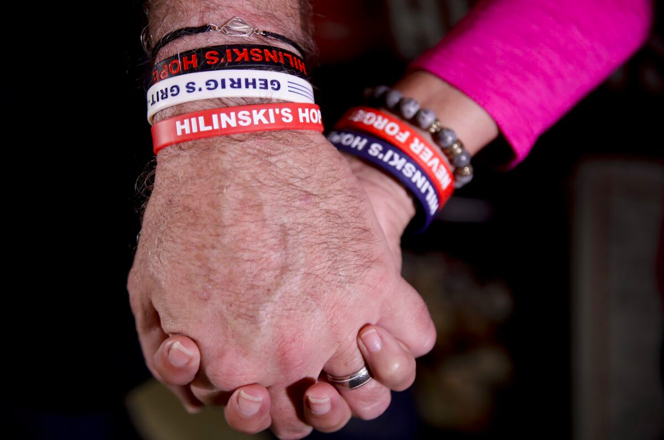Hilinski’s Hope Foundation visits San Diego State to spread mental health message
The San Diego Union-Tribune
Mark and Kym Hilinski stand near midcourt at Viejas Arena, looking up at about 500 San Diego State athletes, coaches and staff members.
On the scoreboard overhead during their one-hour talk are still and video images of son Tyler, a quarterback at Washington State.
It has been five years since Tyler Hilinski died by suicide.
The emotion remains raw. The anguish is still real.
Mark Hilinski goes first, his words interrupted frequently as he clears his throat, reaches for a bottle of water or pauses to gather himself.
Witnessing his pain is almost unbearable to watch.
But mental health must be addressed.
“We recognize that it is a very important topic,” John David Wicker, SDSU’s director of athletics, said during his introduction of the Hilinskis. “We hear that from you (athletes) on a regular basis, so we’ve really been working hard to create as many opportunities to get in front of you, to surround you with support on this, whether it’s through our staff or through our folks through counseling and psyche services.”
Or through events such as “Tyler Talks.” Mark and Kym created Hilinski’s Hope Foundation to address mental health for student-athletes, and they have shared the story at more than 160 colleges and universities across the country. They visited San Diego State last Sunday.
“The point isn’t to make you uncomfortable,” Mark Hilinski said. “The point is to find some hope in the story.”
He pauses.
“Tyler should still be here.
“So, if we can talk about that a little bit, and really give each other a break a little bit, I think we’ll be better off.”
Tyler Hilinski seemingly had everything going for him.
He was the Hilinskis’ middle son, all three of them college quarterbacks who grew up in Southern California.
In 2017, Tyler was a junior at Washington State, where he went from backup quarterback to emerging star in Mike Leach’s pass-happy offense.
Luke Falk was the Cougars’ starting QB, but Hilinski got a chance when Falk struggled in an early-season game against Boise State.
Washington State was down 21 points with six minutes to play before Hilinski rallied the Cougars to a 47-44 victory in triple overtime.
During a video shown during the Tyler Talk, a voiceover announcer says of the Boise State game, “they carried him off the field that night under the lights. There were a lot of things right with Tyler Hilinski. But there was something wrong, too. Something dark and ominous that took hold of his soul and wouldn’t let go.”
No one watching could see that in the moment. Tyler was described as easygoing with a bright smile.
He had another opportunity later in the season, replacing Falk against Arizona.
Tyler accounted for four scores and 509 passing yards — all in the second half.
He also threw four interceptions in the 58-37 loss.
Hilinski started in place of Falk in the 2017 Holiday Bowl, where the Cougars were beaten 42-17 by Michigan State.
It was his last game.
Three weeks later, following a winter break vacation to Mexico with his family, Tyler killed himself.
It was later revealed following an autopsy that Tyler had Stage 1 CTE, the degenerative brain disease linked with hits to the head.
Whether that contributed in some way to Tyler’s death remains among the questions that always come back to this: Why?
“As parents, that’s all we’re ever asking,” Mark said.
Depression is among the symptoms for Stage 1 CTE.
Tyler couldn’t ask or didn’t know how to ask for help.
Mark told a story about Tyler driving his roommmate to counseling. Tyler would wait in the car outside during the sessions, then drive them home afterwards.
“They’d sit in the car for about an hour and sometimes they’d talk about the whole experience,” Mark said. “Deep, heavy stuff for these guys ...
“He was 20 feet from where (his teammate) got help.”
But couldn’t get the help himself.
Mark told the story about how Tyler, when he was 17, called late one night be brought home from a party when he was being pressured to do something he didn’t want to do.
They get Tyler home, “he goes to bed and Kym and I, standing in the kitchen, high-fiving as parents” that Tyler listened to the speeches about calling — regardless of the problem — if you ever need help.
“He’s 17,” Mark said. “What happened?”
Why couldn’t Tyler ask for help when he was 21?
“Did Tyler not say anything because he didn’t want to lose his job?” Mark said. “Maybe.
“Was he embarrassed? Probably. I don’t know.”
Former SDSU linebacker Michael Shawcroft was among those who attended the event.
Shawcroft has been active on the subject of mental health, helping organize an on-campus group that encourages athletes to share what they’re shouldering.
“Talking about mental health is something that every school, every university should do because student-athletes are all pretty similar in that we all go through a lot and we all push it,” Shawcroft said. “The majority of athletes can push through it, but a lot of people have setbacks. They have stuff at home that they don’t talk about. They’re going through their own struggles.”
Two people can go through the same situation, Shawcroft said, and be impacted in completely different ways. One moves on while the other one is stuck.
“And they don’t know what to do,” he said. “Just talking helps a lot. A lot of people don’t realize that.”
Wicker said COVID-19 exacerbated the situation.
“It was very challenging for everybody,” he said, “so we’ve really tried to work on the resources on campus.”
In recent months, SDSU has added an LVN with a mental health background and added a sports psychologist to the medical providers the Aztecs use.
The Mountain West Health & Safety Advisory Committee also was created.
This was in addition, school officials said, to existing services, which included a close relationship with Counseling and Psyche Services and two psychologists being used who have sports backgrounds.
There also are mental health components to programs called Aztec Warrior Wellness and Aztecs Going Pro.
“It’s not always easy,” said Wicker, while addressing the athletes. “Sometimes, you’re feeling low, whatever it may be.
“Have the courage to talk to somebody. And if you’re a friend and you see somebody you feel is a little off, they’re struggling a little bit, have the courage to say, ‘Hey, what’s going on?’
“Wrap your arms around them. That’s what we’re here to do.”
Hilinski’s Hope is one more way to get in front of the subject.
“This is a tragic story but also one that is a very powerful story,” Wicker said.
The mission for Hilinski’s hope also includes connecting students to mental health resources as well as assisting both universities and high schools with mental health best practices.
During her time with the microphone, Kym Hilinski mentioned how “People say, ‘You’re so strong. How do you keep telling Tyler’s story over and over?’
“And I have a different word for it.
“I call it love. I love my son so much. ... When someone does die, you don’t stop loving them. This is how I continue to show Tyler and our student-athletes how much I love them.”
Kym said that when Tyler died, they sat down as a family, she, Mark, older son Kelly and younger son Ryan, to determine “how we try to live and breathe and walk again without our son.”
They came up with three choices.
The first option was to remain in Southern California, “dig our heads in the sand and ignore the fact that our son left by suicide.”
Kym said that didn’t seem right.
“That would really be enforcing that stigma, and that’s just not what we’re about,” she said.
The second choice was to run away.
“We were going to find an island somewhere,” she said, “and we were going to live on it, try to find peace.”
Running away didn’t seem right, either.
“The third option was to form Hilinski’s Hope to honor Tyler,” Kym said, “and to support the mental health of our student-athletes as we do.”
Kym referenced a quote the Hilinskis live by: “They say you die twice. Once when you take your last breath. A bit later on, when someone says your name for the last time.
“I’m not going to let my son die twice.”
She still struggles with the thought that, “I didn’t know he was sick. I didn’t know he was struggling. He didn’t tell me.”
Kym remembers back to the postgame press conference after the big Boise State victory.
Tyler spotted her as he entered the room and said, “Hey, momma.”
“I hear that voice everyday,” Kym said. “And it keeps me moving and working to support our student-athletes.”
One of the most visible ways of support is a wrist band they give out. It has Hilinski’s Hope and 3 (Tyler’s jersey number) on the outside.
Inside are numbers to call for help: 1 (800) 273-8255 or 988.
“I get a lot of emails and texts and calls,” Kym said, “from student-athletes that tell me, ‘I was in a bad place. I was struggling. I turned that band inside out and I called that number.’ Don’t be afraid to call that number.”
The day he died, Tyler waited until his roommates left their apartment. That way, no one else would be hurt.
When he missed practice, a search began for him. Tyler was found in an apartment closet. He shot himself.
He left a short note, but its contents provided no explanation.
His laptop and iPad were in plain sight, but his phone was hidden.
Six months after their son died, the Hilinskis received a call from the police. Tyler’s phone had been found by the people who moved into his apartment.
The phone was shipped to his parents, who tried to get into it to find some answers.
“We all take shots at his password,” Mark Hilinski said. “IPhones, you do it 10 times, they pause you and finally wipe out your data. So we didn’t want to do that.”
So they turned to a company with expertise unlocking phones.
“They sent us all the data on a big 5-terabyte drive or whatever,” Mark said. “So we could click and look at pictures and who he was talking to.
“Guys, there is nothing in that phone of value to share with you, other than a couple things.”
One thing was Tyler’s password.
He was notorious for having something simple, like the same number repeated over and over or consecutive numbers like 123456.
When the phone was returned from being unlocked there was a yellow stickie attached to it that read PW: 767799
“That’s not a password,” Mark said. “Tyler couldn’t remember that. Not because he was stupid, but he just didn’t do that. It wasn’t in his pattern. It didn’t make sense.”
Two weeks later, Mark got a call from his wife, who believed she figured out what the digits represented.
Said Mark: “The only English language word that matches ... those numbers is: sorry.”
S-O-R-R-Y-Y.
Tyler had changed his password a couple of days before he died.
“I don’t know who he was saying sorry to,” Mark said. “I don’t know if he was saying sorry.”
“There wasn’t ‘Dear Mom, Dear Dad, this is why I have to go.’ It wasn’t that.”
Pause.
“Sorry,” he repeats. “Don’t be sorry yourself. Don’t be sorry asking for help.”
“If you’re the guy or the woman that your teammates come and say, ‘We’re worried about you,’ whatever the reasons., listen to them. Even if they’re wrong, a lot of good stuff can happen. ...
“It shouldn’t and doesn’t take a tragedy to ask for help. ... Don’t wait for a tragedy. You deserve the help if you need it.”

